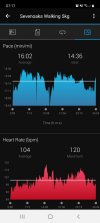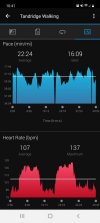Gary W
Level 5 Valued Member
So i do my strength training 3 days a week MWF and have been just walking, unloaded 2/3miles on a Tuesday and Thursday with a MTB ride on the weekend.
I want to start doing the walks loaded,
5/10kg in a back pack, not sure my bag will take much more than that.
Im planing to drive to a near by hill, park at the top and walk down then back up for 30mins total.
I only get 1hr in the mornings, its a 10min drive each way only leaves me 30/40 mins for the walk.
Will i benefit from 30mins at all, or do i need longer?
Im hoping it will help my hill climbing on the bike?
I want to start doing the walks loaded,
5/10kg in a back pack, not sure my bag will take much more than that.
Im planing to drive to a near by hill, park at the top and walk down then back up for 30mins total.
I only get 1hr in the mornings, its a 10min drive each way only leaves me 30/40 mins for the walk.
Will i benefit from 30mins at all, or do i need longer?
Im hoping it will help my hill climbing on the bike?


